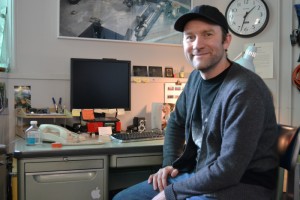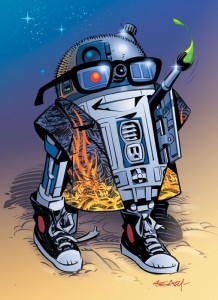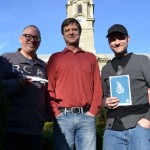To some students, teachers are those people who stand at the front of a class for hours and blab on and on when the students would rather be at home watching Netflix and petting their cat. And to others, they are their mentors, the people who can teach them invaluable skills.
But those who think that people that work at the college are the most boring people in the world need to think again, because they hardly know the whole story.
Nexus recently spoke with three Camosun staff members and found out what they do behind the scenes. What we got to hear were three interesting and unique stories, ones that Camosun students wouldn’t normally hear if they were just taking one of these people’s classes or using their department’s services.
The man who likes to play with fire
Anton Skinner is the head of the audio/visual department at Camosun. He and his team are in charge of all the classroom equipment, the college’s visual and audio aids, and installations. They take care of photography and video for all departments at the college and also run two full-time service counters to help students with their requirements in the classroom.
With Skinner and his team visiting classrooms and troubleshooting technological problems, his job description seems like it should be “college superhero,” because Skinner says they “save people all day long.”

But while he works at Camosun, Skinner also pursues another career. His away-from-college title is “pyrotechnician”; for those who aren’t familiar, it means that he’s responsible for handling explosives in the entertainment industry.
Skinner started at Butchart Gardens in 1986, worked there for a decade, and then branched off into a more theatrical world. He has been working for the Royal and McPherson Theatres for 32 years and also throws 600 “bombs” off the Inner Harbour for Symphony Splash every year.
Because Skinner has both his federal indoor and outdoor pyro licences, and a good relationship with the Victoria Fire Department, he got offered a contract to work at Save-on-Foods Memorial Centre with the big concerts and shows that tour through town.
Skinner thought it would just be a temporary thing, but he liked it so much he kept on doing it. Now, when shows stop in Victoria that feature pyrotechnics, Skinner is the go-to guy.
“When there are visiting pyrotechnicians from other countries, they are not allowed to use their licence to purchase and shoot off fireworks in Canada. There has to be a Canadian federal licence on hand,” he explains. “So when KISS, Nickelback, these bands that come in that have pyrotechnics, I get called up.”
Skinner says he gets to be the chief for crews of up to 110 people. He doesn’t travel with the bands: he supervises the other pyros that do. The technicians that travel with the band know what the performer likes and how it’s supposed to be set up, but if something were to go wrong, Skinner holds the permit, so it would be him and his licence that would face any consequences.
Over the years he has gotten to work with famous artists and do small jobs for movies and commercials. Looking back, he remembers working onstage with a very famous heavy-metal artist.
“One of my fondest memories was when Ozzy Osbourne came on the stage and said, ‘I want to see a test.’ So we set a few pieces off for him and he stood there and said, ‘What? That’s it!?’ and we said, ‘We just showed you a couple, but times that by 50,’ and he says, ‘Show it all!’ So we had to shoot everything off and then prepare for the show,” he remembers.
Skinner started at Camosun in 1999 when the entertainment industry got too strenuous for him while he was trying to raise kids. But the great thing about his other job is that he can go back whenever he wants.
“I could disappear and go and live in a desert for four years, come back, and slide right back into my position,” he says. Although living in the desert does seem a little… dry, Skinner realizes that this could be his retirement job, because the industry will have work for him when he is ready for it.
In fact, he was recently at Save-on-Foods Centre getting ready for Bryan Adams’ performances.
Talk about a cool side job.
A photographer and his historical methods
Art instructor Michael McLean is one of three instructional technologists at Camosun teaching the fundamental skills and the technical ins and outs of the art mediums that students here get to use.
McLean attended university as an English Literature major and was studying in the library one night for a test on “Victorian era poetry or something that wasn’t particularly interesting,” he recalls. As a distraction, McLean picked up a book that was sitting on the table that happened to be filled with photographs.
It was a book of documentary photographs from the extermination camps of Eastern Europe. As he flipped through the book, he was astounded at this fantastic and yet terrible project, and the more pages he turned, the more he realized that this is what he wanted to do.

McLean discovered for himself that pictures communicate in ways that words never could.
The last picture in the book was taken from inside a gas chamber that was never used, and a small child of about seven years old was photographed running out the open door. This photo has impacted McLean to this very day.
“I saw that picture and it’s like it was burned into my memory and that was it. I finished the semester out and no longer took any literature classes; I enrolled in art and it’s been that way ever since,” he says.
Three years ago, McLean worked on a project where he took 100 digital photos a day for 365 days. When the year was over, he got all the images printed, collected them together in a montage, and put them up at the Open Space gallery for an exhibition.
McLean says that, as an artist, he has a tendency to do a project and take it as far as he can, then go in the complete opposite direction. So, he decided to figure out what the furthest thing from this last digital project could be, but still have it exist in the realm of photography.
McLean dug out his photo-history textbooks and researched the old historical methods. Next thing he knew, he had a grant from the government and was using the money to go to England to learn these very old techniques.
McLean got to learn the old methods in the home of William Henry Fox Talbot, who was a photography pioneer born in the year 1800. He also travelled to Paris and Burgundy, France, where the first photograph ever was taken.
McLean came home and started putting what he had learned to use. It has taken him more than two years to really get a feel for how these historical methods work, but he has really grown to appreciate them.
“I like the idea that that’s how they did it in the 1830s and the 1840s,” says McLean. “They didn’t have flash kits and stuff like that, so I try my best to be as true to the historical technique as possible, but I’m trying to make temporary art using historical techniques and not just making old-looking pictures.”
One project McLean is working on is called Debris. When a Harley Davidson motorcycle washed up on a remote beach after the tsunami in Japan and eventually made its way down to Victoria, McLean had a chance to photograph it. He got to thinking about all the things that wash up on our beaches and the traces that people leave behind them.
He wanted to combine those thoughts with historical methods and ended up choosing a process known as salt printing. This technique is done by floating watercolour, or similar paper, on a dilution of salt water for a minute or two. You then take it off, dry it, and float it on a solution of silver nitrate. McLean found that the results were suited to the project.
Even though McLean has embraced his art’s history and got to experience all of these fascinating things, to pinpoint a moment where he truly recognized and felt grateful for all of his successes, he immediately thinks of Camosun.
“It’s such a beautiful place that we live,” he says. “I think to myself, ‘I just spent seven or eight hours at work doing the thing that I really love to do,’ which is talking to people about making art, and that for me is more rewarding than any exhibition.”
Marvel and DC comic artist among our ranks
Instructor Ken Steacy has been reading comics since before he could even read. When he was 11, he decided that he wanted to be a professional comic-book artist when he grew up, and luckily he had parents that didn’t try to dissuade him from his atypical career choice.
Now Steacy is one of the teachers and creators of the Comics and Graphic Novels program at Camosun College. He has his works published by comics giants Marvel and DC, along with countless others.
As a young person trying to break into the comic scene, there was only one place for Steacy to go: New York. Back in the day there was no internet, so if you wanted a shot at this career you had to physically get yourself all the way there to the conventions and hope to get an interview, which Steacy managed to do.

“I was offered work at Marvel and I thought I should have been ecstatic, because I finally achieved what I’d set out to do, but I wasn’t happy,” he said. “I took a long, hard look at who I was and what I was doing and realized that all I could do was a mediocre imitation of other people’s work.”
So Steacy went back to school to try and unlearn some bad habits and bring in some new ones.
After that, his career split into three branches: graphic design, illustration, and comics. He was quick to leave behind design and illustrating because comics had always been his one true goal. Around that time, a publisher from San Francisco wanted him to do some work. Steacy offered up a piece that he already had underway called The Sacred and the Profane. It got published, and he started to get noticed.
Now, years later, instead of him listing off what he has illustrated and who has published him, it seems easier for him just to say what he hasn’t done.
“I’ve done Harry Potter, and Star Wars, and Iron Man, and Batman. I’ve done Spider-Man, and Ghostbusters, and Astro Boy, and there’s one that I haven’t done yet and it really upsets me; I cannot die happy knowing I haven’t done this character,” he laughs. “I have not done Archie. I so want to do Archie.”
Currently, Steacy has some projects that he’s very excited about. A graphic novel he wrote years ago with American writer Harlan Ellison, called Night and the Enemy, is going to be reprinted and out in fall of this year. It was originally published in 1987 and, as far as Steacy knows, it sold out.
Another project Steacy has been working on is a graphic novel about two generations of fighter pilots whose damaged relationship is mended while restoring a trainer they had both flown during their careers. This story is inspired by one of Steacy’s other interests, which is building scale models.
He says that people who write comics and people who build models have something in common, and it’s that they are great storytellers. The first thing any modeller will tell you is the histories from which their models came, he says.
Steacy also looks forward to the Desert Bus for Hope fundraiser every year, even though it isn’t a personal project. The goal is to try and raise money for children’s hospitals by auctioning off handmade art and other goods; he personally sells his collectibles, originals, artwork, and commissioned pieces.
“So far I have raised over $150,000, and I am so grateful for that opportunity,” says Steacy. “They have raised over $2 million over the course of these events that they put on, and this is a bunch of 20-something gamers who do this out of the goodness of their hearts.”
Steacy has made six appearances for Desert Bus already and wants to keep going back.

It’s weird to realize how little we actually know about our teachers and staff here at Camosun. The old photo printing processes that Michael McLean uses would be non-existent to me if I hadn’t talked to him, and I barely knew what a pyrotechnician was before having a chance to hear about what Anton Skinner does. Ken Steacy, whom countless students will pass today in the hallway, has done so much in his field that he actually travels around and signs autographs.
These are only three of the Camosun staff; imagine how many great stories we haven’t heard yet. It’s hard to remember through the 1,000 pages of reading and the Mount Everests of homework that the people that teach and guide us are also people with lives and people with cool stories.
